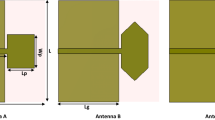Abstract
This paper proposes frequency reconfigurable antennas using genetic algorithm, suitable for cognitive radio applications. The optimization is applied to find the slot shape and the switches locations in the ground plane of monopole antennas for adjustment of the bandwidth. We introduce a new cost function appropriate for designing antennas for cognitive radio applications. In the first design, the presented antenna can operate in the band of 1.9–3.8 GHz and two sub-bands 1.8–2.78 and 2.78–3.8 GHz using the possible minimum number of switches. In the second design, the proposed antenna works in a wide operating band of 1.85–4 GHz and three different sub-bands 1.72–2.27, 2.27–2.9 and 2.9–3.75 GHz. The proposed antenna with three modes of operation is fabricated and the comparison of the simulated and measured results shows a good agreement.










Similar content being viewed by others
References
Tawk, Y., Costantine, J., & Christodoulou, C. G. (2014). Cognitive-radio and antenna functionalities: A tutorial. IEEE Antennas and Propagation Magazine, 56(1), 231–243.
Hussain, R., & Sharawi, M. S. (2015). A cognitive radio reconfigurable MIMO and sensing antenna system. IEEE Antennas and Wireless Propagation Letters, 14, 257–260.
Pazin, L., & Leviatan, Y. (2013). Reconfigurable slot antenna for switchable multiband operation in a wide frequency range. IEEE Antennas and Wireless Propagation Letters, 12, 329–332.
Cai, Y., JayGuo, Y., & Bird, T. S. (2012). A frequency reconfigurable printed Yagi–Uda dipole antenna for cognitive radio applications. IEEE Transactions on Antennas and Propagation, 60(6), 2905–2912.
Ge, L., Li, M., Wang, J., & Gu, H. (2017). Unidirectional dual-band stacked patch antenna with independent frequency reconfiguration. IEEE Antennas and Wireless Propagation Letters, 16, 113–116.
Hussain, R., & Sharawi, M. S. (2016). Planar meandered-F-shaped 4-element reconfigurable multiple-input-multiple-output antenna system with isolation enhancement for cognitive radio platforms. IET Microwave, Antennas & Propagation, 10(1), 45–52.
Rajagopalan, H., Kovitz, J. M., & Rahmat-Samii, Y. (2014). MEMS reconfigurable optimized E-shaped patch antenna design for cognitive radio. IEEE Transactions on Antennas and Propagation, 62(3), 1056–1064.
Tawk, Y., & Christodoulou, C. G. (2009). A new reconfigurable antenna design for cognitive radio. IEEE Antennas and Wireless Propagation Letters, 8, 1378–1381.
Joseph, S. D., Manoj, S., Waghmare, C., Nandakumar, K., & Kothari, A. (2017). UWB sensing antenna, reconfigurable transceiver and reconfigurable antenna based cognitive radio test bed. Wireless Personal Communications, 96(3), 3435–3462.
Jin, G., Liao, H., & Liu, D. (2016). A dual-port frequency reconfigurable antenna for cognitive radio applications. In IEEE International Conference on Computational Electromagnetics. Guangzhou, China, pp. 292–294.
Ge, L., & Luk, K. M. (2016). Band-reconfigurable unidirectional antenna: a simple, efficient magneto-electric antenna for cognitive radio applications. IEEE Antennas and Propagation Magazine, 58(2), 18–27.
Mansoul, A., Ghanem, F., Hamid, M. R., & Trabelsi, M. (2014). A selective frequency reconfigurable antenna for cognitive radio applications. IEEE Antennas and Wireless Propagation Letters, 13, 515–518.
Quijano, J. L. A., & Vecchi, G. (2009). Optimization of an innovative type of compact frequency reconfigurable antenna. IEEE Transactions on Antennas and Propagation, 57(1), 9–18.
Song, S., & Murch, R. A. (2014). An efficient approach for optimizing frequency reconfigurable pixel antennas using genetic algorithms. IEEE Transactions on Antennas and Propagation, 62(2), 609–620.
Karoui, M. S., Ghariani, H., Samet, M., Ramdani, M., & Perdriau, R. (2010). Bandwidth enhancement of the square/rectangular patch antenna for biotelemetry applications. International Journal of Information Systems and Telecommunication Engineering, 1, 12–18.
‘High Frequency Structure Simulator (HFSS) Ver. 15’. http://www.ansys.com.
Deb, A., Roy, J. S., & Gupta, B. (2014). Performance comparison of differential evolution, particle swarm optimization and genetic algorithm in the design of circularly polarized microstrip antennas. IEEE Transactions on Antennas and Propagation, 62(8), 3920–3939.
Author information
Authors and Affiliations
Corresponding author
Rights and permissions
About this article
Cite this article
Zadehparizi, F., Jam, S. Frequency Reconfigurable Antennas Design for Cognitive Radio Applications with Different Number of Sub-bands Based on Genetic Algorithm. Wireless Pers Commun 98, 3431–3441 (2018). https://doi.org/10.1007/s11277-017-5022-5
Published:
Issue Date:
DOI: https://doi.org/10.1007/s11277-017-5022-5




